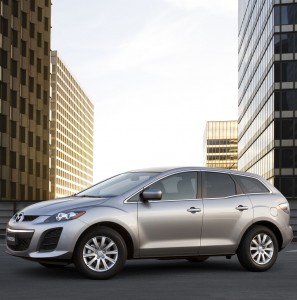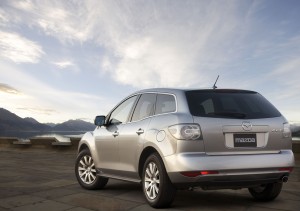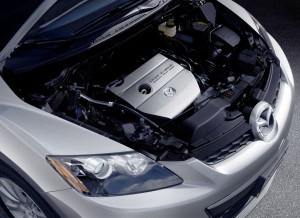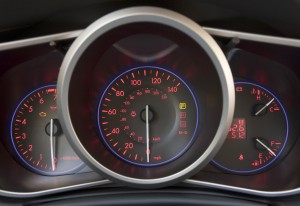From the time Mazda introduced it, the CX-7 seemed like a cool, sporty crossover, just with the wrong engine. The 2.3-liter turbocharged direct-injected four cylinder, such a wild and lusty engine in the MazdaSpeed 3 and the short-lived MazdaSpeed 6, was an odd choice for what is really a fairly big vehicle.
Fuel economy was also not a strong suit for the CX-7, which hit the market as a 2007 model. For 2010, Mazda responded to customer requests for a more fuel-efficient powertrain when it did a mild makeover of its sexy two-row crossover. Rated at 18 city and 25 highway with front-wheel drive, those numbers were hard to achieve because the little turbo seemed to have to work fairly hard to push the CX-7.
The new, base CX-7 comes with a normally aspirated 2.5-liter four cylinder. Rated at 161 horsepower and 161 lb.-ft. of torque, the new engine comes with a rating of 20/28 mpg.
While all-wheel-drive is an option with the turbo motor, the less-powerful engine is front-wheel-drive only.
The refresh also includes mildly revised styling, inside and out, plus a revised structure and improved suspension.
The turbo engine has always seemed like a strange choice for the CX-7. Yes, the sporty Mazda looks like a sports car on stilts, but a regular V-6 seems like it would be a better choice. The turbo engine’s fuel economy isn’t very good, it doesn’t have as much low-end grunt as the engines in many other smaller crossovers and towing is limited to a paltry 2,000 pounds.
Then again, the turbo motor sets the CX-7 apart from the competition. Crossovers and SUVs with V-6s are like belly buttons: Everyone has one.
But the regular four cylinder changes the situation. Now, the CX-7 can compete with entry-level versions of crossovers such as the Chevrolet Equinox, Toyota RAV4 and Honda CR-V.
On that front, the CX-7 is a mixed bag. It’s swoopy good looks are delightful, arguably the best-looking crossover in its class. The interior is comfortable and Mazda sporty.
But all is not perfect. The turbo-less four cylinder has a lot of weight – nearly 3,500 pounds – to tug around for just 161 horses. Passing on two-lane roads can be uncomfortable because acceleration is tepid. The engine is somewhat buzzy when accelerating, but it hums along without complaint when cruising.
One would think that flip side of limited power and sluggish acceleration would be stellar fuel economy. But that thought would be wrong. It gives up 2 mpg city and 4 highway, to the four cylinder Equinox, 1 each to the Kia Sorrento.
Once up to speed, the CX-7 doesn’t have very good path control. It tends to wander on the freeway and the steering isn’t very accurate, requiring constant corrections.
The ride is smooth and composed. It handles well with no hint that the front wheels are doing all the work. The five-speed automatic shifts smoothly and is quick to downshift when asked.
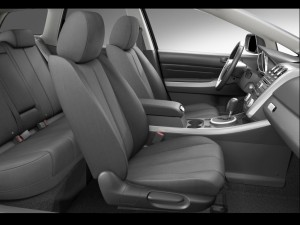
Mazda's swoopy CX-7 has a comfortable, if somewhat cramped interior. That's the price of high style.
All of the controls work with a silky smoothness that would suggest a more expensive vehicle and the gauges are well-marked and easy to read. The instrument panel lighting scheme is improved from previous Mazdas which were either too bright at night or too dark during the day.
The folks sitting in front have plenty of space and the seats are long-haul comfortable. Space in back is somewhat tighter. The lower roof impinges on headroom and the kneeroom is also limited compared to others in this class. Cargo space is slightly less, too. The sacrifices we make in the name of style.
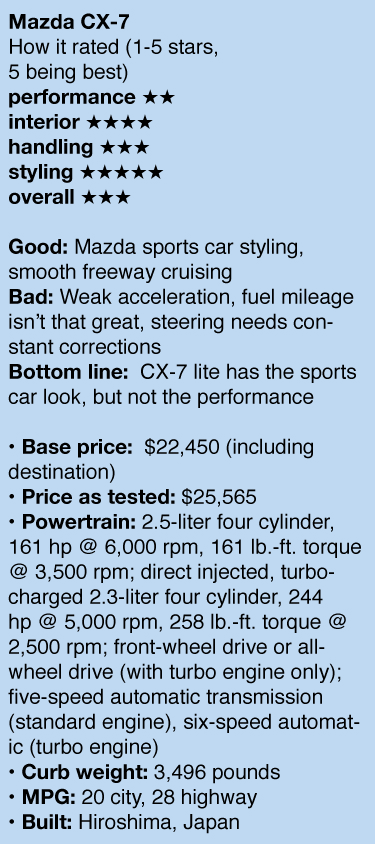 Mazda has done a great job extending the bulging front fender look from its iconic RX-8 sports car to models throughout the lineup, including the Mazda 6 and even the bigger CX-9 crossover. It’s a distinctive look.
Mazda has done a great job extending the bulging front fender look from its iconic RX-8 sports car to models throughout the lineup, including the Mazda 6 and even the bigger CX-9 crossover. It’s a distinctive look.
The CX-7 i SV is a bargain, starting at $22,450, including destination, for the base i SV four cylinder. That price includes 17-inch alloy wheels, remote keyless entry, steering wheel-mounted audio controls, stability control and traction control, not to mention the usual extensive list of airbags.
With options including a convenience package ($1,750 for heated front seats, power moonroof, rearview camera, power driver’s seat and automatic climate control), the test vehicle rang the cash register at $25,565. The least expensive turbo model, the s Touring, starts at $26,700.
If you’re looking for a crossover with a dose of sports car in its DNA, the CX-7 is a fun choice.

